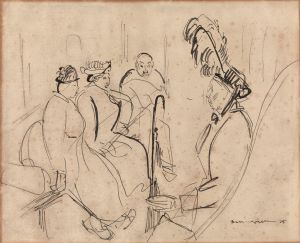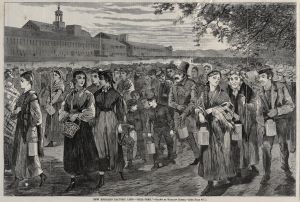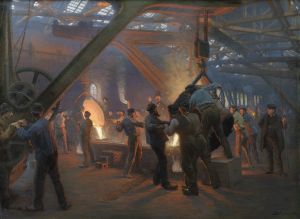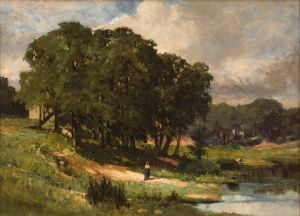
Train
A hand-painted replica of Edward Mitchell Bannister’s masterpiece Train, meticulously crafted by professional artists to capture the true essence of the original. Each piece is created with museum-quality canvas and rare mineral pigments, carefully painted by experienced artists with delicate brushstrokes and rich, layered colors to perfectly recreate the texture of the original artwork. Unlike machine-printed reproductions, this hand-painted version brings the painting to life, infused with the artist’s emotions and skill in every stroke. Whether for personal collection or home decoration, it instantly elevates the artistic atmosphere of any space.
Edward Mitchell Bannister was a prominent African American artist known for his contributions to the American art scene in the 19th century. Born in 1828 in St. Andrews, New Brunswick, Canada, Bannister later moved to the United States, where he became an influential figure in the art community. Despite the racial barriers of his time, he achieved significant recognition for his work, particularly in landscape painting.
One of Bannister's notable works is "Train," a painting that exemplifies his skill in capturing the essence of the natural world. Although specific details about the painting "Train" are limited, Bannister's body of work is characterized by his use of the Barbizon style, which emphasizes naturalism and the depiction of rural scenes. This style was inspired by the French Barbizon School, which focused on painting landscapes directly from nature, often with a focus on the effects of light and atmosphere.
Bannister's paintings often reflect his deep appreciation for the natural environment, and he was known for his ability to convey mood and emotion through his landscapes. His work typically features soft, muted colors and a keen attention to detail, which help to create a sense of tranquility and harmony within his compositions. Bannister's landscapes often include elements such as trees, fields, and bodies of water, which he rendered with a delicate touch and a keen eye for the subtleties of light and shadow.
Despite the challenges he faced as an African American artist in the 19th century, Bannister achieved considerable success and recognition during his lifetime. He was a founding member of the Providence Art Club in Rhode Island, one of the oldest art clubs in the United States, and he exhibited his work widely. In 1876, Bannister won a bronze medal at the Philadelphia Centennial Exposition for his painting "Under the Oaks," a significant achievement that helped to establish his reputation as a talented and respected artist.
Bannister's work is an important part of American art history, as it reflects both the artistic trends of his time and his personal vision as an artist. His ability to transcend the racial prejudices of his era and gain recognition for his talent is a testament to his dedication and passion for his craft. Today, Bannister's paintings are held in various collections, and his legacy continues to inspire and influence artists and art enthusiasts alike.
While specific information about the painting "Train" is limited, Edward Mitchell Bannister's overall contribution to the art world remains significant. His landscapes continue to be celebrated for their beauty, technical skill, and emotional depth, securing his place as a pioneering figure in American art.

















